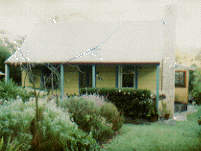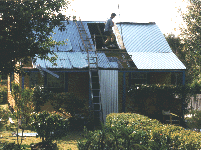 In the early days at Helensburgh, most of the land around the mine was either owned by the mine itself or the Department of Lands. With the opening of the mine, workers and their families moved into town. The mining company itself built a number of small cottages for the miners, but most workers were left to fend for themselves. One acre parcels of land were purchased by the miners and typical workmen’s cottages were built in varying degrees of craftsmanship. Some of the cottages were little more than bush logs daubed with mud and lined with hessian painted with whitewash. Other cottages were more substantial in that they used milled timber and at least had some form of footings, usually sandstone rocks. They all looked the same, although only the more substantial cottages remain today. Most were later “renovated”, the front verandah closed in, fibro sheeting replacing the timber cladding, all with numerous extensions.
In the early days at Helensburgh, most of the land around the mine was either owned by the mine itself or the Department of Lands. With the opening of the mine, workers and their families moved into town. The mining company itself built a number of small cottages for the miners, but most workers were left to fend for themselves. One acre parcels of land were purchased by the miners and typical workmen’s cottages were built in varying degrees of craftsmanship. Some of the cottages were little more than bush logs daubed with mud and lined with hessian painted with whitewash. Other cottages were more substantial in that they used milled timber and at least had some form of footings, usually sandstone rocks. They all looked the same, although only the more substantial cottages remain today. Most were later “renovated”, the front verandah closed in, fibro sheeting replacing the timber cladding, all with numerous extensions.
 The original cottages consisted of four rooms, a living room and three bedrooms. Out the back of the house was a smaller wash-house and kitchen. This consisted of two rooms, one for cooking and washing, and the other for eating. On the front verandah of this building was a bench where the men would wash up after a day at the mine. These buildings were particularly useful in summer in that they isolated the heat of the fuel stove from the main house. Few remain today, replaced by the “extension”.
The original cottages consisted of four rooms, a living room and three bedrooms. Out the back of the house was a smaller wash-house and kitchen. This consisted of two rooms, one for cooking and washing, and the other for eating. On the front verandah of this building was a bench where the men would wash up after a day at the mine. These buildings were particularly useful in summer in that they isolated the heat of the fuel stove from the main house. Few remain today, replaced by the “extension”.
In the early 1970s Helensburgh began to see an influx of new residents. The Sydney suburban sprawl had started to reach the Burgh (pronounced “the Berg”). In 1975 a miner’s cottage could be had for $15,000, well below a comparable land package in the outer suburbs of Sydney. With the pressure of new buyers into the market this price would soon increase to over $50,000 in 1982 and unrestored examples on a small parcel of land from $250,000 in 2000. Most people who purchased a miner’s cottage, lived in it for a time and then when they had enough money, demolished it and built a new home. As there was usually plenty of land, the new home was built behind the old cottage which was then demolished after the new home was completed.
 The government policy on land sizes changed in the ’80s and ’90s and so the larger blocks of land in Helensburgh were subdivided. Inevitably more miner’s cottages were demolished in the process.
The government policy on land sizes changed in the ’80s and ’90s and so the larger blocks of land in Helensburgh were subdivided. Inevitably more miner’s cottages were demolished in the process.
By the ’90s there was a change in attitude toward the few remaining miner’s cottages in town. The old locals had been born and raised in them and were happy to see them demolished, but many new arrivals found them quaint relics of the past. So began a move to restore the few remaining examples of homes that epitomized life in a working class community. By now none stood on their original acre of land and many of these sat on small slivers of land with new homes all around them. None-the-less, some nice examples remain.
 The example pictured, called “Pumpkin Cottage”, was built around the turn of the century on about three quarters of an acre, one of the few properly constructed with milled timber. It was fenced with a loose stone wall, part of which still remains on a neighbouring property. There was a well. This too is now on a neighbouring property and is still used to top up the neighbours swimming pool. The land around the cottage was subdivided off on both sides in 1960. The cottage is situated in old Helensburgh, “Struggle Town” (it’s a struggle to get up to the shops from the bottom end of town). Unlike most of these cottages it is set back from the street-front and this gives it quite a pretty feel. It consists of an iron roof, original hardwood planking sides, pine floors and pine lined walls. Much of the original interior remains. As is typical of these cottages, extensions were added to the rear of the building over the years – kitchen/family, bathroom, laundry. The cottage was landscaped by Stan Somerson who was actually born in the cottage. Stan died in the late ’90s, having lived his whole life in the cottage. Stan claims that he planted the Angophora gum at the front of the property when he was a young boy as punishment for having chopped down the original tree. Stan’s tree is now massive.
The example pictured, called “Pumpkin Cottage”, was built around the turn of the century on about three quarters of an acre, one of the few properly constructed with milled timber. It was fenced with a loose stone wall, part of which still remains on a neighbouring property. There was a well. This too is now on a neighbouring property and is still used to top up the neighbours swimming pool. The land around the cottage was subdivided off on both sides in 1960. The cottage is situated in old Helensburgh, “Struggle Town” (it’s a struggle to get up to the shops from the bottom end of town). Unlike most of these cottages it is set back from the street-front and this gives it quite a pretty feel. It consists of an iron roof, original hardwood planking sides, pine floors and pine lined walls. Much of the original interior remains. As is typical of these cottages, extensions were added to the rear of the building over the years – kitchen/family, bathroom, laundry. The cottage was landscaped by Stan Somerson who was actually born in the cottage. Stan died in the late ’90s, having lived his whole life in the cottage. Stan claims that he planted the Angophora gum at the front of the property when he was a young boy as punishment for having chopped down the original tree. Stan’s tree is now massive.
In 1999 a full restoration project was undertaken by Bryan and Doreen Findlayson. This involved the opening out of the interior of the original cottage, rebuilding of the lounge fireplace, insulation and new iron roof, part demolition (only floors and part walls remained) and reinstatement of the rear extensions, rebuilding of the fuel stove alcove, combining of the bathroom and laundry, a new enlarged back deck over the original brick and stone decking, rewiring of electricals, air conditioner, and renovation of kitchen and bathroom with hardwood benches and recycled Oregon cupboards.